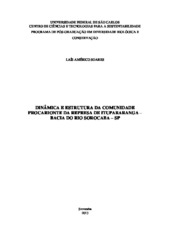| dc.contributor.author | Soares, Laís Américo | |
| dc.date.accessioned | 2016-06-02T19:26:22Z | |
| dc.date.available | 2013-11-29 | |
| dc.date.available | 2016-06-02T19:26:22Z | |
| dc.date.issued | 2013-05-17 | |
| dc.identifier.uri | https://repositorio.ufscar.br/handle/ufscar/1526 | |
| dc.description.abstract | This work aimed to quantifier the archaeal and bacterial communities by real time PCR, that shown the number of copies of 16S gene, rDNA into the water samples and to compare the archaeal and bacterial profiles on the PCR/DGGE technique as well as relate them with environmental variables in two points, dam and input on the Itupararanga reservoir, Sorocaba s basin. The bacterial density on the sediment (6,09 x108 e 2,56 x 109, dam and input, respectively) was more than water column (6,79 x 107 e 6,55 x 107, dam and input, respectively) this can be attributed to increase of the nutrients concentration from the surface to bottom. The bacterial (6,09 x 108 e 2,56 x 109 dam and input, respectively ) and archaeal (2,31 x 102 e 4,49 x 102 dam and input, respectively) quantities on the reservoir were more in the water column than in the sediment, which can be caused by the higher nutrients concentration in the top and the lees nutrients concentration in the bottom of Itupararanga reservoir. Since the canonical correspondence analysis has been possible, identify that the archaeal community has correlated with profundity and ammonia concentration suggesting ammonia oxidizing archaea s presence and abundance. The bacterial community quantity has correlated with physical chemical properties like pH and dissolved oxygen suggesting the environmental variables influence the group s abundance. Richness has correlated with nutrients distribution like orthophosphate concentration suggesting that the resources may limit the communities. | eng |
| dc.description.sponsorship | Universidade Federal de Sao Carlos | |
| dc.format | application/pdf | por |
| dc.language | por | por |
| dc.publisher | Universidade Federal de São Carlos | por |
| dc.rights | Acesso Aberto | por |
| dc.subject | archaea | por |
| dc.subject | bacteria | por |
| dc.subject | coluna de água | por |
| dc.subject | PCR tempo real | por |
| dc.subject | PCR/DGGE | por |
| dc.subject | sedimento | por |
| dc.subject | archaea Rio Sorocaba (SP) | por |
| dc.subject | bactérias Rio Sorocaba (SP) | por |
| dc.subject | archaea | eng |
| dc.subject | bacteria | eng |
| dc.subject | real time PCR | eng |
| dc.subject | PCR/DGGE | eng |
| dc.subject | sediment | eng |
| dc.subject | water column. | eng |
| dc.title | Dinâmica e estrutura da comunidade procarionte da represa de Itupararanga - bacia do Rio Sorocaba - SP. | por |
| dc.title.alternative | Structure and Dynamic of prokaryote communities on the Itupararanga reservoir, basin of Sorocaba s river SP. | eng |
| dc.type | Dissertação | por |
| dc.contributor.advisor1 | Santos, André Cordeiro Alves dos | |
| dc.contributor.advisor1Lattes | http://lattes.cnpq.br/2131880667704281 | por |
| dc.contributor.referee1 | Duarte, Iolanda Cristina Silveira | |
| dc.contributor.referee1Lattes | http://buscatextual.cnpq.br/buscatextual/visualizacv.do?id=K4794095Y8 | por |
| dc.contributor.referee2 | Falco, Patrícia Bortoletto de | |
| dc.contributor.referee2Lattes | http://lattes.cnpq.br/8402787438350814 | por |
| dc.description.resumo | Com este trabalho objetivou-se quantificar a comunidade de bactérias e arqueias por meio de PCR em tempo real que determina o número de cópias do gene 16S de rDNA presentes nas amostras ambientais e comparar as comunidades de arqueia e bactérias em um perfil de bandas de PCR/DGGE, bem como relacioná-las às variáveis ambientais de dois pontos, Entrada e Barragem do reservatório de Itupararanga, bacia do rio Sorocaba. A quantidade de bactérias (6,09 x 108 e 2,56 x 109 barragem e entrada, respectivamente) e de arqueias (2,31 x 102 e 4,49 x 102 barragem e entrada, respectivamente) no sedimento foi maior do que na coluna d água o que pode ser atribuído ao aumento da concentração de nutrientes da superfície para o fundo do reservatório. A partir de análise de correspondência canônica foi possível observar que a quantidade de arqueias relacionou-se a profundidade e à concentração de íons amônio indicando possível presença e abundância de arqueias amônio oxidantes (AOA), enquanto que as bactérias foram mais relacionadas às variáveis físico-químicas, como temperatura e oxigênio dissolvido indicando que este grupo é mais sensível às variações ambientais. A riqueza de ambos os grupos foi relacionada à disponibilidade de nutrientes, indicando que os recursos podem ser limitantes às comunidades. | por |
| dc.publisher.country | BR | por |
| dc.publisher.initials | UFSCar | por |
| dc.publisher.program | Programa de Pos-graduação em Diversidade Biológica e Conservação | por |
| dc.subject.cnpq | CIENCIAS BIOLOGICAS::ECOLOGIA | por |
| dc.contributor.authorlattes | http://buscatextual.cnpq.br/buscatextual/visualizacv.do?id=K4420135D9 | por |
